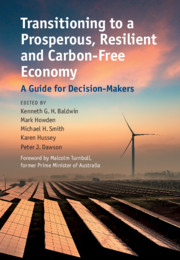Book contents
- Transitioning to a Prosperous, Resilient and Carbon-Free Economy
- Transitioning to a Prosperous, Resilient and Carbon-Free Economy
- Copyright page
- Dedication
- Contents
- Figures
- Tables
- Contributors
- Foreword
- Introduction
- 1 Policy Frameworks and Institutions for Decarbonisation: The Energy Sector as ‘Litmus Test’
- Technologies for Decarbonising the Electricity Sector
- Example Economies
- 9 Decarbonisation Strategies and Economic Opportunities in Australia
- 10 Decarbonisation Strategies and Economic Opportunities in Indonesia
- Cities and Industry
- Land Use, Forests and Agriculture
- Mining, Metals, Oil and Gas
- Addressing Barriers io Change
- Index
- References
9 - Decarbonisation Strategies and Economic Opportunities in Australia
from Example Economies
Published online by Cambridge University Press: 08 October 2021
- Transitioning to a Prosperous, Resilient and Carbon-Free Economy
- Transitioning to a Prosperous, Resilient and Carbon-Free Economy
- Copyright page
- Dedication
- Contents
- Figures
- Tables
- Contributors
- Foreword
- Introduction
- 1 Policy Frameworks and Institutions for Decarbonisation: The Energy Sector as ‘Litmus Test’
- Technologies for Decarbonising the Electricity Sector
- Example Economies
- 9 Decarbonisation Strategies and Economic Opportunities in Australia
- 10 Decarbonisation Strategies and Economic Opportunities in Indonesia
- Cities and Industry
- Land Use, Forests and Agriculture
- Mining, Metals, Oil and Gas
- Addressing Barriers io Change
- Index
- References
Summary
This chapter synthesises insights from the Deep Decarbonisation Pathways Project (DDPP), which provided detailed analysis of how 16 countries representing three-quarters of global emissions can transition to very low-carbon economies. The four ‘pillars’ of decarbonisation are identified as: achieving low or zero-carbon electricity supply; electrification and fuel switching in transport, industry and housing; ambitious energy efficiency improvements; and reducing non-energy emissions. The chapter focuses on decarbonisation scenarios for Australia. It shows that electricity supply can be readily decarbonised and greatly expanded to cater for electrification of transport, industry and buildings. There would be remaining emissions principally from industry and agriculture, these could be fully compensated through land-based carbon sequestration. The analysis shows that such decarbonisation would be consistent with continued growth in GDP and trade, and would require very little change in economic structure of Australia’s economy. Australia is rich in renewable energy potential, which could re-enable new industries such as energy-intensive manufacturing for export
Keywords
- Type
- Chapter
- Information
- Transitioning to a Prosperous, Resilient and Carbon-Free EconomyA Guide for Decision-Makers, pp. 203 - 236Publisher: Cambridge University PressPrint publication year: 2021



